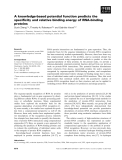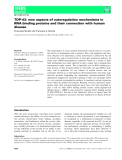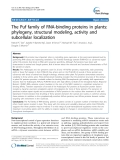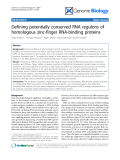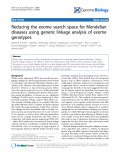
78
Journal of Medicine and Pharmacy, Volume 12, No.07/2022
Transcriptome - wide bioinformatics analysis of the binding sites of
RNA - binding proteins and their putative role in mendelian diseases
Phan Nguyen Anh Thu1, Matteo Floris2, Maria Laura Idda3, Nguyen Hoang Bach4*
(1) Department of Physiology, University of Medicine and Pharmacy, Hue University
(2) Department of Science Biomedicine, Sassari University
(3) National Research Council - Institute of Genetic and Biomedical Research (CNR-IRGB)
(4) Department of Microbiology, University of Medicine and Pharmacy, Hue University
Abstract
Background: Post-transcriptional regulation is the control of gene expression at the RNA level. After
produced, the stability and distribution of the different transcripts are regulated by means of RNA-binding
proteins (RBPs). Mutations in RNA-binding proteins can cause Mendelian diseases - prominently neuro-
muscular disorders and cancers. This study determines the interaction between RBPs and target-RNA
complexes from public data of the ENCODE project and identifies mutations associated with Mendelian
diseases that could disrupt the RBP-RNA interactions. Materials and methods: we performed a transcriptome
- wide bioinformatics prediction of the binding sites of RBPs in the human transcriptome from public
data of the ENCODE project. Results: The majority (54%) of pathogenic mutation putatively affecting the
binding sites of RBPs are located in protein - coding genes and are mainly classified as loss - of - function
mutations. Mutations located in the binding sites of RBPs related to RNA processing. For 13 diseases, Familial
hypercholesterolemia is the most significant disease with about 40% of mutations in ClinVar database located
into the binding sites of RBPs (p=2.3e-65), but congenital hypogonadotropic hypogonadism is the disease
with the highest percentage of mutations affecting the binding sites of RBPs (98%, p=2.7e-25). The RBPs
most involved in human Mendelian diseases by binding sites-disrupting mutations are YBX3, AQR and PRPF8.
Conclusions: A large number of Mendelian diseases are potentially mediated by disease - causing variants
that potentially disrupt the binding sites of RBPs. This will provide insight sharper on post - transcriptional
mechanisms. Besides, it is useful to know the role of protein - RNA interactome networks in pathologies,
thereby serving the treatment of diseases.
Keywords: bioinformatics analysis, ENCODE project, ClinVar, RNA-binding proteins, Mendelian diseases.
1. INTRODUCTION
Post-transcriptional regulation, also known as the
control of gene expression at the RNA level, occurs
between the transcription and translation of the
gene [1]. It makes a significant contribution to the
control of gene expression in all human tissues [2,3].
After being produced, the stability and distribution
of the different transcripts are regulated by means
of RNA - binding proteins (RBPs). RBPs are widely
and abundantly produced in cells. They participate
and coordinate crucially in maintaining the integrity
of the genome and play a crucial and conserved
role in gene regulation. RBPs have a wide range of
functions, including regulating polyadenylation,
splicing, translation, editing, and post-transcriptional
regulation of mRNA stability, which ultimately affects
the expression of every gene in the cell [4]. RBPs also
contain regulatory regions that post-transcriptionally
affect gene expression [5].
The role and process by which these proteins
control gene expression is of great interest, and
there is evidence of their involvement in a wide
range of illnesses. Recent research has identified
human cell in vivo mRNA interactions that are linked
to more than 1.100 RBPs. Most RNAs interact with
all proteins, and many proteins interact with several
RNAs [6]. RNA - protein networks, which control
gene expression at the RNA level, are formed as
a result of the combinations of individual RNA -
protein interactions [7]. Defects or deregulation
of RNA - protein networks often cause disease.
Cancers and Mendelian diseases, particularly
neuro - muscular disorders can be brought on by
mutations in RBPs[8–10]. In this work, we first
determined the interaction between the RBPs
and target-RNA complexes from public data of the
ENCODE project (Encode Project Consortium, 2004)
[11]. In particular, we identified disease mutations
associated with Mendelian diseases that could
disrupt the RBP-RNA interactions.
Corresponding author: Nguyen Hoang Bach, email: nhbach@huemed-univ.edu.vn
Recieved: 22/10/2022; Accepted: 28/11/2022; Published: 30/12/2022
DOI: 10.34071/jmp.2022.7.11






